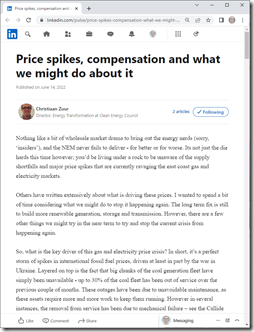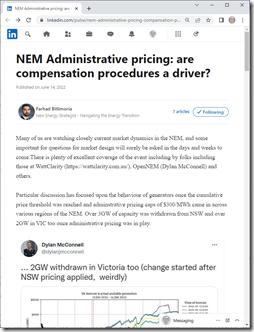I was in the process of publishing this article prior to the suspension of the market at 14:00 on Wednesday 15th June 2022 … and note that Compensation under Market Suspension has its own rules and processes. However I thought it would be still useful to post this here for later reference…
———
There’s been an escalating amount of commentary recently about the process by which generators are to be compensated in the current situation where all four mainland regions are well in excess of the Cumulative Price Threshold, so Administered Pricing is being used … including discussions about what appears to be the selection of one form of compensation (from AEMO) over the other (from the AEMC).
Like many others, I’ve found myself at the bottom of a steep learning curve about these two approaches, and struggling to climb quickly – so this article is written with that in mind (and hence lots of ‘Reader Beware!’ disclaimers should be noted).
With that in mind, the following might still be of some value to some readers:
| AEMC Process
Compensation due to Administered Price Cap (APC) |
AEMO Process
‘NEM Administrative pricing: are compensation procedures a driver?’ |
|---|---|
|
This is what the AEMC published news update ‘How to lodge a claim for compensation’ was related to. … and on Wednesday 15th June published further guidance to the market about the administered price cap (APC) compensation process. It’s my understanding that this is the process that should be used under our current conditions of Administered Pricing in play across the 4 x Mainland Regions. |
The AEMO reasonably frequently needs to direct certain participants to do certain things … (a) for instance it has been used reasonably regularly in relation to maintaining sufficient system strength in South Australia during windy periods where prices are typically low. (b) other WattClarity articles have been tagged with AEMO Direction/Intervention and might be of some value. The AEMO has documentation for how these processes work … such as this ‘Procedures for Issue of Directions and Clause 4.89 Instructions’. |
Since the imposition of Administered Pricing (beginning in QLD on Sunday evening 12th June) there’s been an increase number of incidents noticed that seem to broadly follow the following pattern:
Step 1 = Some DUIDs have capacity withdrawn from the NEM
Step 2 = In aggregate this means a drop in Available Generation in the region
Step 3 = This has triggered forecasts of LOR3 Low Reserve Condition in the near future (e.g. that evening, or the next morning)
Step 4 = Which has led AEMO to intervene and Direct some DUIDs to make themselves available
Step 5 = So at the point of dispatch, there is sufficient capacity to meet demand
Step 6 = With compensation subsequently determined under the AEMO Process.
On Monday 13th June I flagged some yo-yo cases here and have started to work through these progressively – but have not finished yet (so, again, ‘Reader Beware’ disclaimer) as other events have since ensued. However I have been trying to learn about the processes underlying this.
In my travels online I’ve found the following two pieces of external discussion (from Christiaan and Farhad) that I thought would be useful to readers here:
| from Christiaan Zuur
‘Price spikes, compensation and what we might do about it’ |
from Farhad Billimoria
‘NEM Administrative pricing: are compensation procedures a driver?’ |
|---|---|
|
Disclaimer and Caution: With respect to these articles (and these general topics) I am operating beyond my level of understanding … the articles seem to be useful, and the comments I read underneath at this point don’t highlight any substantial errors, so I’m choosing to share them with our readers here in the interests of increasing the overall level of the conversation about what’s going on. |
|
|
Yesterday I saw Christian write ‘Price spikes, compensation and what we might do about it’ and it might be useful: Nothing further to add here.. |
Yesterday I also saw Farhad write ‘NEM Administrative pricing: are compensation procedures a driver?’ and it might be useful: Nothing further to add here…
|
In the days and weeks ahead I might have time to learn more, and share more at WattClarity here.




Leave a comment